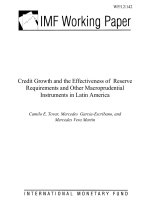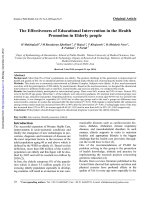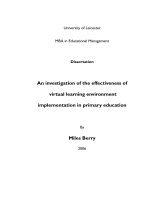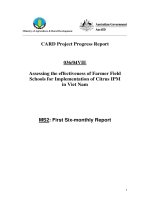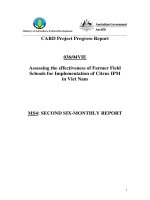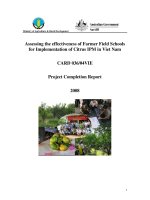Learning AIDS in Singapore: Examining the effectiveness of HIV/AIDS efficacy messages for adolescents using ICTs
Bạn đang xem bản rút gọn của tài liệu. Xem và tải ngay bản đầy đủ của tài liệu tại đây (350.83 KB, 19 trang )
Knowledge Management & E-Learning: An International Journal, Vol.2, No.2.
169
Learning AIDS in Singapore: Examining the Effectiveness
of HIV/AIDS Efficacy Messages for Adolescents Using ICTs
Arul Indrasen Chib*
Wee Kim Wee School of Communication and Information
Nanyang Technological University
31 Nanyang Link, Singapore 637718
E-mail:
*Corresponding author
May O. Lwin
Wee Kim Wee School of Communication and Information
Nanyang Technological University
31 Nanyang Link, Singapore 637718
E-mail:
Zhuomin Lee
Wee Kim Wee School of Communication and Information
Nanyang Technological University
31 Nanyang Link, Singapore 637718
Victoria W. Ng
Wee Kim Wee School of Communication and Information
Nanyang Technological University
31 Nanyang Link, Singapore 637718
Priscilla H. P. Wong
Wee Kim Wee School of Communication and Information
Nanyang Technological University
31 Nanyang Link, Singapore 637718
The objective of this study was to assess adolescents‘
receptivity to the use of new interactive media for dissemination of
sensitive health messages. We propose a conceptual framework based
on the Extended Parallel Process Model (EPPM) to design a gamebased HIV/AIDS intervention for adolescents. Amongst key findings,
we found that Game Play led to changes in attitudes and intentions.
Abstract:
Keywords: HIV, AIDS, Health Communications, Intervention, Games.
170
Chib, A.I. et al.
Biographical notes: Arul Indrasen Chib is an Assistant Professor of the Wee
Kim Wee School of Communication and Information at Nanyang
Technological University, Singapore. He received his Ph.D. degree in
Communications from University of Southern California, USA.
May O. Lwin is an Associate Professor of the Wee Kim Wee School of
Communication and Information at Nanyang Technological University,
Singapore. She received her Ph.D. degree in Business Administration from
National University of Singapore, Singapore.
Zhuomin Lee is a graduate of the Wee Kim Wee School of Communication and
Information at Nanyang Technological University, Singapore.
Victoria W. Ng is a graduate of the Wee Kim Wee School of Communication
and Information at Nanyang Technological University, Singapore.
Priscilla H. P. Wong is a graduate of the Wee Kim Wee School of
Communication and Information at Nanyang Technological University,
Singapore.
1. Introduction
About half the world‘s HIV positive population today is made up of young people aged
15-24. An estimated 12.5 million adolescents living with HIV/AIDS are expected to
escalate, with an increasing proportion of new infections occurring in young people
(UNAIDS, 2008). In Singapore, the Ministry of Health (MoH) reports that the numbers
of new HIV/AIDS infections reached a record high of 423 in 2007 (357 in 2006), since
the first reported case in 1985 (MoH, 2009).
Adolescents are identified as a highly vulnerable group because of their proclivity
towards high-risk sexual behaviors (Gubhaju, 2002; Quek & Li, 2002; UNFPA, 2002).
Often, such adolescents are not fully aware of the consequences of their actions (Quek &
Li, 2002), or have misconceptions towards HIV/AIDS (Gubhaju, 2002). In Asia,
changing cultural norms and false media portrayals have also led to a growing trend of
early sexual activity and low use of contraception among young people in several
countries of the region (UNICEF, 2005). In Singapore, adolescents are becoming
sexually active at an earlier age (Quek & Li, 2002); increasingly, they do so without
taking protective measures (Hussain & Kwek, 2005). Further, they do not have
information on their bodies, the perils of unprotected sex and modes of prevention
(Bharwani, 2008).
The centrality of education in prevention and mitigation of the HIV/AIDS
epidemic is critical. Unfortunately, the HIV/AIDS programs implemented (Ministry of
Education, 2002) have been criticized for lack of consistency (Cormont-Ku, 2008; Tan,
2009). Recently scholars begin to focus on the use of interactive games in educating
youth on health behaviors (Bandura, 2004; Brown, Lieberman, Gemeny, Fan, Wilson, &
Pasta, 1997; Chib, 2008; Lieberman, 2001; Thomas, Cahill, & Santini, 1997).
We propose a conceptual framework based on the Extended Parallel Process
Model (EPPM) to design a game-based HIV/AIDS intervention for adolescents. The
objective of this study was to assess adolescents‘ receptivity to the use of new interactive
media for dissemination of sensitive health messages, and secondly, understand the role
of threat and efficacy messages in HIV/AIDS interventions.
Knowledge Management & E-Learning: An International Journal, Vol.2, No.2.
171
2. Issues in Current Sexual Health Education
While the literature acknowledges the key role of parental guidance, its effectiveness is
often limited by parents‘ embarrassment when discussing sexual issues with their
children (Baldwin, Li, Shah, & Zhang, 2007; Cui, Gao, & Li, 2001). Increasingly, studies
have shown that school-based HIV programs are effective in reducing risk-taking
behaviors (Abner et al., 2007a; Kyrychenko, Kohler, & Sathiakumar, 2006).
Asian countries began HIV/AIDS educational campaigns (Xinhua, 2003), yet,
policy-makers have been slow to act on this recommendation (Aggleton & Warwick,
2002). Taboos and sensitivities surrounding the issue of sex in some communities also
make it difficult for people to broach topics related to sexual issues (Hoe, 2007).While
the Singaporean Health Promotion Board has prepared the AIDS Education Program and
―The Growing Years‖ series, it is unclear if these programs were successful as
implementation is optional (Ministry of Education, 2002).
Further, they may not be well-received as a young, highly media literate
generation pay less attention to conventional messages that are largely moralistic and
didactic in nature. The new generation of adolescents may instead respond better to
information and communication technologies (ICTs) such as videos, digital games and
the Internet (Miller et al., 2008; Squire, 2002).
The issues surrounding current sexual health programs suggest the need to
revolutionize HIV/AIDS interventions in schools. Miller et al. (2008) point out the
benefits of interactive multimedia platforms to reduce adolescent at-risk behavior, which
can particularly be harnessed in Singapore. First, computer penetration rates are high in
Singapore, with more than 90% of school-going adolescents having access to computers
and Internet at home (Infocomm Development Authority of Singapore [IDA], 2008).
Moreover, the use of computer and the Internet have become increasingly ubiquitous in
the lifestyles of young people, with adolescents between ages 15 and 24 reporting the
highest usage of the computer and the Internet (IDA, 2008).
Recognizing human capital as a valued asset of the country, the Singapore
government integrated interactive multimedia ICTs into the school curriculum, leading to
schools sufficiently equipped with necessary and modern facilities to enable digital-based
learning (Mokhtar, Foo, & Shaheen, 2007).
Health communication scholars have begun to focus on the use of interactive
games in influencing health behaviors (Bandura, 2004; Brown et al., 1997; Chib, 2008;
Lieberman, 2001). Unlike commercial games, which are purely entertainment products,
health games are designed to achieve specific health outcomes, and thus are lower in
production qualities such as resolution and usability (Rizzo & McLaughlin, 2006).
Although still in its early stages, computer-based applications have been used to
educate youth on a wide range of health issues such as substance abuse (Aryl,
Beauchamp, Duncan, Duncan, & Wells, 2000; Glassman, Noia, & Schinke, 2004),
alcohol use (LaChausse, 2006), and sexual and reproductive health matters (Abner et al.,
2007a; Abner, Carlyle, Roberto, & Zimmerman, 2007b). Among some successful game
based applications, Lieberman (2001) found a considerable improvement in the self-care
skills of sufferers of chronic diseases such as asthma after playing a series of interactive
Nintendo games. In another study on post-stroke rehabilitation, it was found that serious
games with virtual reality helped improve patient movements such as reaching (Holden,
Todorov, Callahan, Bizzi, 1999), hand movements (Merians et al., 2002) and walking
(Deutsch, Latonio, Burdea, & Boian, 2001; You et al., 2005).
172
Chib, A.I. et al.
Despite the growing body of literature supporting the effectiveness of serious
games in learning and health outcomes, research on digital game-based learning has been
criticized for its emphasis on effects of intervention and failure to develop valid theory
explicating the mechanisms behind the effects (Singhal & Rogers 2001). Thus, we
propose to address this gap by developing a HIV/AIDS game-intervention based on
strong theoretical underpinnings. This study integrates the benefits of digital gaming with
EPPM in influencing attitudes and intentions towards HIV/AIDS protective measures.
3. Conceptual Framework
Fear appeals are persuasive messages that mix threat messages with recommended
measures to promote protective behaviors, and are based on assumptions about the role of
fear arousal in motivating protective behaviors (Rogers, 1983). Although fear appeals
have been widely employed in HIV/AIDS preventive campaigns over the last two
decades (Ross & Rigby, 1990), proof of effectiveness remains inconclusive, with some
studies reporting the success of fear appeals in precautionary motivation, and others
failure (Beaudoin, 2002; Cho & Salmon, 2006; Murray-Johnson, Witte, Liu, & Hubbel,
2001; Witte, 1992).
Leventhal (1970) explanation is that fear arousal triggers two parallel processes in
individuals, namely danger and fear control processes. When danger control processes
dominate, individuals develop protective strategies to alleviate the danger. When fear
control dominates as a result of excessive fear arousal, individuals actively alleviate fear
through message denigration (Bargh, 1989; Lazarus, 1991a; 1991b).
In view of this advancement, researchers began imbuing fear appeals with specific
protective behavior guides in order to mitigate the influence of fear arousal (Eiser & Pligt,
1989). According to Sarafino (1990), emphasizing the role of efficacy through specific
advice and prevention strategy boosting one‘s confidence, thus increasing the
effectiveness of fear appeals‘ in motivating behavior change.
Thus far, fear appeals theories such as Protection Motivation Model (PMT) and
Extended Parallel Process Model (EPPM) have incorporated the component of efficacy in
their revised frameworks. The PMT is a revised fear appeals theory that combines
efficacy components with threat components. However, despite improvisations, the PMT
still fails to explain why message rejection occurs and how threat appraisal and coping
appraisal interact to influence consequent behavioral changes (Witte, 1992).
EPPM was chosen as the overarching theoretical framework to explicate the
mechanisms behind the effects of game-based interventions, because it integrates the
parallel process model and PMT (Nabi, Roskos-Ewoldsen & Carpentier, 2008), filling in
gaps left by both theories (See Figure 1). Specifically, EPPM addresses limitations of
previous fear appeals theories on three fronts.
First, unlike previous theories, EPPM expands on fear control processes,
explaining when and why message rejection occurs. Next, it explains the interaction of
threat and efficacy in fear appeal studies. Lastly, EPPM allows for distinction between
individuals engaging in fear or danger control processes through a discriminating value
formula, making it an excellent predictive model for further theorizing (Witte, 1992).
EPPM examines the conditions under which fear appeals may succeed or fail in
persuading the audience (Witte, 1992; 1998; Witte, Meyer & Martell, 2001). It comprises
two main variables—perceived threat and perceived efficacy. Perceived threat consists of
two variables—perceived susceptibility and severity. Perceived susceptibility to threat is
Knowledge Management & E-Learning: An International Journal, Vol.2, No.2.
173
a person‘s perceived likelihood of the risk happening to the individual (e.g. ‗You are at
risk of getting HIV‘). Perceived severity is a person‘s perception of how serious the risk
is (e.g. ‗You can die from AIDS‘). Perceived efficacy comprises of two components,
namely self-efficacy and response efficacy. Self-efficacy refers to an individual‘s belief
in his capacity to perform a recommended behavior (e.g. ‗I am confident of resisting
sexual pressure‘), while response efficacy refers to an individual‘s belief in the usefulness
of the message recommended behavior in reducing the threat (e.g ‗I believe that condoms
can prevent HIV/AIDS‘).
According to EPPM, threat stimuli are crucial to message processing because they
result in fear arousal, causing one to feel more involved and pay attention to the message.
When fear arousal is low, individuals disregard the relevance of risks, thus impeding
message processing (Witte, 1992). Conversely, fear arousal will trigger the second
appraisal-an assessment of the efficacy of recommended responses in persuasive
communications only when perceptions of threat are medium or high (Easterling &
Leventhal, 1989; Lang, 1984).
EPPM postulates that when confronted with a health threat, individuals minimize
their fears either by controlling the danger or controlling their fear. Danger controls are
cognitive processes where individuals develop protective strategies to alleviate the danger.
Whereas, fear control processes are described as emotional processes that promote
defensive avoidance, which in turn leads to maladaptive behaviors (Bargh, 1989; Lazarus,
1991a; 1991b).
Perceived efficacy plays a critical role in determining whether individuals engage
in danger or fear control (Witte, 1992). EPPM predicts that when both perceived threat
and efficacy are high, danger control processes dominate; conversely when perceived
threats are high and perceived efficacy is low, fear control processes dominate (Witte,
1992).
1
1
Figure 1. Extended Parallel Process Model (EPPM)
From ―Fear Control and Danger Control: A Test on The Extended Parallel Process Model
(EPPM)‖ by Witte, K, 1994, Communication Monographs, 61, p. 115.
174
Chib, A.I. et al.
Several studies have demonstrated robust evidence of the role of perceived
efficacy in influencing behavior change. For example, Beck & Lund (1981) found strong
interactions between at least one component of threat dimension and efficacy dimension
in influencing intentions to adopt protective measures. Similarly, Abner et al. (2007)
found that fear appeals are useful in affecting behavior change when accompanied by
components of efficacy. Yet other scholars have shown support for efficacy in health
intervention programs (Abner et al., 2007; Kyrychenko et al., 2006). In view of the
crucial role of efficacy in health communications, we posit the following research
question.
Research question: Given high perceived threat of HIV/AIDS, what is the role of
efficacy in HIV/AIDS intervention programs in prompting danger control
(adaptive) or fear control (maladaptive) processes?
Although EPPM has been used in various HIV/AIDS campaigns, most studies
using EPPM have focused on these two divergent processes of fear and danger control
(Witte & Allen, 2000). While cognitive processes occurring in danger control processes
may influence attitudes, intentions and behavior changes (Witte, 1992), there seems to be
a lack of research exploring this (Stephenson, Holbert & Zimmerman, 2006). The
relationship between EPPM variables (i.e. severity, susceptibility, and self-efficacy and
response efficacy) and attitudes, intentions and behavior changes remains underexplored,
and this thus provides an opportunity for research. Based on the existing EPPM
framework, we propose a testing model as shown in Figure 2.
Figure 2. Proposed Conceptual Framework for HIV/AIDS Attitudes-Intention
model
The present study tests the relationships in the proposed model. Attitudes and
intentions are vital determinants for behavior change to occur (Ajzen, & Fishbein, 1980;
Ajzen, & Madden, 1986). A large body of literature examining the effects of individuals‘
attitudes and intentions (Albarracin, Johnson, & Zanna, 2005) found that when one‘s
attitude towards a certain behavior is positive, intention to act on the recommended
behavior is likely to be positive.
Accordingly, in order for adolescents to reduce sexual risk behavior, attitudes and
intentions towards taking on preventive measures have to be altered. Hence in the
proposed conceptual framework, attitudes and intentions are added to investigate their
relationship with EPPM variables. In light of the objectives of the study, the following
hypotheses were tested.
Knowledge Management & E-Learning: An International Journal, Vol.2, No.2.
175
H1: Game Playing will lead to a positive increase in attitudes (H1a) and intentions
(H1b) towards HIV/AIDS protective measures.
H2: Given the same level of threat messages, participants who are exposed to high
efficacy messages will display a greater increase in attitudes and intentions
towards HIV/AIDS protective measures, than participants who are exposed to
low efficacy messages
H2a and H2b: Given the same level of threat messages, participants who are
exposed to high response efficacy messages will display a greater increase in
attitudes (H2a) and intentions (H2b) towards HIV/AIDS protective measures,
than participants who are exposed to low response efficacy messages
H2c and H2d: Given the same level of threat messages, participants who are
exposed to high self-efficacy messages will display a greater increase in
attitudes (H2c) and intentions (H2d) towards HIV/AIDS protective measures,
than participants who are exposed to low self-efficacy messages
H3: An increase in attitudes will lead to a positive change in intentions (Ajzen &
Madden, 1986).
This research project occurred in two phases. Formative research was exploratory
in nature and employed as part of a larger game-based HIV/AIDS intervention program.
The principle objective was to understand the optimal level of threat and efficacy
messages to develop into message components and game design principles for
adolescents. Findings from formative research were used to develop an interactive
multimedia game. The evaluative study employed a quantitative approach through a
quasi-experiment to test the effectiveness of efficacy components in the interactive game.
4. Formative research
A qualitative approach to the formative research was suitable because of its exploratory
nature, and it allowed the researchers to gain a better understanding of adolescents‘
perceptions. The researchers utilized the semi-structured interview method guided by an
interview guide.
4.1. Sample
Data for the formative research was obtained from fifteen in-depth interviews conducted
from September to November 2008 with gender-mixed participants from boys only, girls
only and mixed schools.
Singaporean adolescents aged between 14-16 years were recruited through a
snowballing technique. Participants received no monetary payment. Each interview took
about 90 minutes and was voice-recorded for transcribing purposes. Due to the sensitive
nature of the topic, a memorandum of understanding was highlighted to ensure
confidentiality.
4.2. Measures and Analysis
The interviews covered three topic areas. These included how Singaporean adolescents
felt towards current HIV/AIDS education programs, the kinds of HIV/AIDS messages
176
Chib, A.I. et al.
perceived to be high/low threat and efficacy, and the different elements of interactive
multimedia that prove engaging.
In order to elicit responses on threat and efficacy levels, interviewees categorized
a dozen posters according to varying levels of fear and efficacy, and elaborated on their
choices. In order to identify elements of interactive multi-media games that were
engaging, interviewees were exposed to various activities, videos and quizzes related to
sexual health. Thematic coding was used to analyze data collected (Boyatzis, 1998).
4.3. Game Design
Formative research showed that adolescent participants enjoyed interactive experiences
with role-playing, emotional narrative, feedbacks and quizzes in comparison to traditional
one-way learning formats.
A common theme raised was that sexual health programs were often integrated
through subjects such as biology and moral education with one-way and results-oriented
teaching styles. Independent workshops on HIV/AIDS, when available, were usually in
the form of mass lectures and video screenings. As a result, students often ―tuned out‖.
―Once, they called us to the auditorium, and there‘s this speaker who talked
about pre-marital sex and its consequences. It‘s supposed to be interactive but it
turned out to be like a lecture telling you what you should do and what you
shouldn‘t. I think it‘s a waste of time. For those Science classes, teachers teach
only those topics that will come out in the exams. Boring!‖
-Female, 15; all girls‘ school
Another recurring issue was an overemphasis on factual information, resulting in
the neglect of emotional and psychological aspects of sexual health issues. Specifically,
students felt that educators often failed to address coping behaviors.
―On the Internet I help people to deal with their relationships, like a love
counselor kind of thing and there was this case where the guy wanted sex and
the girl kept rejecting. So I told her to think about the consequences and leave
him if he forces her. Not only girls, even boys feel pressure from their peers to
have sex. So, I think schools should teach us how to handle situations like
these.‖ - Male, 15; mixed school
Posters that emphasized on the effectiveness of protective measures in preventing
HIV/AIDS were perceived to be highly efficacious. Respondents perceived posters to be
highly threatening when the message was targeted specifically at adolescents. For
example, most interviewees perceived poster 2 [‗Every minute, five young people get
HIV‘] as highly threatening because of the relevance.
―By saying that ‗Every minute, five young people get HIV‘, I think about myself
and how the consequences impact me. Makes it quite scary!‖ - Female, 14; all
girls‘ school
Posters that emphasized the long-term consequences of contracting HIV/AIDS
were also perceived as highly threatening, particularly when occurring within a social
context. Most adolescents perceived poster 8 as highly threatening due to its portrayal of
HIV/AIDS as a stigmatized disease leading to ostracism.
―The person in this poster is sitting alone in the shadows and it sort of says that
when you get AIDS, everyone will ditch you. Very poor thing!‖ – Female, 15;
all girls‘ school
Knowledge Management & E-Learning: An International Journal, Vol.2, No.2.
177
Adolescents were receptive to interactive multimedia, with role-playing games
preferred. Choice of characters and decision-making were important, and the storyline of
a love triangle was fun and engaging. Role-playing games simulated real-life situations
where adolescents could learn by observing how decision-making altered outcomes.
―I like this [role playing] game better. There are more things to do like I can
guess and press next and guess and press next. This one helps me tell the process,
like maybe if I press next again, I can see the girl slap the guy. It‘s also better
because it is quite real, not like what we see in school textbooks.‖ – Female, 14;
mixed school
Most adolescents enjoyed challenging quizzes for making the learning process fun
and interesting. They preferred the immediate feedback response quizzes offered, because
it helped them learn from their mistakes.
―And have explanations for right or wrong answers. Like if I got the answer
wrong, the right answer will pop out. Even if I got it right through a lucky guess,
an explanation pops out. It saves me the trouble of looking for the answer
myself.‖ – Female, 15; all girls‘ school
In summary, the formative research revealed that sexual health programs in
Singapore were linear and results-oriented, with students often dis-engaged. With new
generations expecting greater interactivity in classroom experiences (Deubel, 2006), it
was clear that Singaporean adolescents required innovative methods of learning (Miller et
al., 2008). These results suggest merit in using digital-game based learning for sexual
health matters.
Based on the formative research, researchers developed an interactive multimedia
game entitled Med Detective, in which threat and efficacy were closely tailored to what
adolescents perceived as high threat and efficacy. High threat was achieved by achieving
high personal relevance by showing videos of adolescents contracting HIV/AIDS,
including disturbing images of STDs and associating them with long-term health
complications. High efficacy was achieved through statements emphasizing the
effectiveness of protective measures, as well as through videos describing condom
negotiation and condom usage.
Enhanced learning of HIV/AIDS was achieved through story telling. Med
Detective was designed after a mystery model allowing players to take on the role of a
detective. Extant literature shows that story telling contributes to a sense of
immersiveness, enjoyment and curiosity, thus serving as an impetus for the disinterested
to learn (Lepper & Henderlong, 2000; Reigeluth & Squire, 1998). Further, a role-playing
game involving a love triangle was included where players decide the outcome of
subjects based on their decisions.
Simulations in role-playing enhance learning as it allows adolescents to make
decisions and observe consequences without any real-world implications (Lieberman,
2008). Lastly quizzes were added in the game with answers rendered immediately to aid
enable information-retention (Reigeluth & Squire, 1998).
178
Chib, A.I. et al.
5. Evaluative Research Methodology
5.1. Sample
One hundred and thirty six participants aged 13-16 were recruited from a secondary
school in Singapore from January to February 2009. Standard demographic information
such as age, gender, race, religion and socioeconomic status were collected. In sum, a
total of 136 secondary three female and male students completed the intervention and all
questionnaires. Students were randomly assigned to two different conditions for the
intervention—high threat and high efficacy (n= 70; Condition 1); high threat only (n= 66;
Condition 2). High levels of threat were maintained in both conditions, while levels of
efficacy were manipulated in the multimedia game.
The gender ratio was even (53.7% males, 46.3% females). The median age was
14 years. The sample was predominantly Chinese (76.3%) followed by Malay (20.7%)
and Indians (0.7%). Buddhism was the predominant religion (41.2%), followed by
Christianity (14.0%), Islam (12.5%) and Taoism (12.5%).
5.2. Procedure
Participants were briefed on answering Likert-type scales, before completing a presurvey questionnaire. The following week, participants individually played the
multimedia game for 30 minutes according to the randomly assigned conditions. Later,
participants completed a post-survey with media queries omitted. Pamphlets and
souvenirs from an NGO, Action for AIDS Singapore, were distributed at the end of the
study, and participants were urged not to disclose any information about the study to their
schoolmates to avoid contamination of control groups.
5.3. Measures
All constructs were measured using multi-item scales a seven-point Likert scale (1 =
Strongly Disagree, 7 = Strongly Agree).
Attitudes and Intentions. Measures were adapted from Witte, Berkowitz, Cameron,
& Lillie (1998). Five items were used to measure attitudes (i.e. ‗Having multiple sex
partners is cool‘) (α= .89), and were reversed coded. Intentions were measured using four
items (i.e. ‗I intend to use condoms when I am sexually active‘) (α= .62).
Perceived Threat and Efficacy. Measures were developed and validated by Witte,
Cameron, McKeon and Berkowitz (1996). Threat was measured using 10 items, with five
items each measuring perceived susceptibility (i.e. ‗I am at risk of getting HIV‘) and
perceived severity (i.e. ‗I believe that HIV is a serious threat to my health‘). A rotated
component matrix was used to eliminate factors that loaded poorly, or factors that loaded
across components. After elimination, the final scale for perceived susceptibility
comprised of three items (α= .79) whereas perceived severity comprised of six (α= .71).
Efficacy was measured using eight items, with four items each measuring
perceived self-efficacy (i.e. I am confident that I can say no to sex) and response efficacy
(i.e. I believe I can prevent HIV by not having sex). After elimination, perceived selfefficacy yielded four items (α= .63) whereas perceived response efficacy yielded three
(α= .36). Alpha coefficients are shown in Table 1.
Manipulation checks. Manipulation checks tested whether perceived efficacy was
successfully manipulated. Independent samples t-tests were run for both self-efficacy
[t(134)=.09 p<.05] and response efficacy [t(134)=.75 p<.05] measures in the pre-test,
with no significant differences observed in the means. A similar test was run for both
Knowledge Management & E-Learning: An International Journal, Vol.2, No.2.
179
self-efficacy [t(123)=.01 p<.05] and response efficacy [t(116)=.00 p<.05] in the post-test.
Results showed a significant difference in the means.
Table 1. Reliability and Means of Scale Items
5.22
Mean of item
SDs
1.12
Cronbach’s
Alpha (α)
.63
3
4.59
1.23
.36
Susceptibility
3
2.29
1.34
.79
Severity
6
5.49
1.05
.71
Attitudes
5
5.65
1.40
.90
Intentions
4
6.09
0.88
.62
Scale
# items
Mean of item
Self-efficacy
4
Response efficacy
6. Results
Hypothesis 1 predicted that Game Play would lead to a positive increase in attitudes and
intentions. The regression results showed that H1a was supported; Game Play was a
significant predictor of attitudes [R2= .09, F(5, 124)= 2.44, p< .05]. This means that a
positive attitude towards protecting oneself is highly related to playing the multimedia
game. H1b was not supported; Game Play was not a significant predictor of intentions.
H2a and H2b predicted that high response efficacy would lead to a positive
increase in attitudes and intentions respectively. From the regression results, H2b was
supported, indicating that response efficacy was a significant predictor of intentions
towards protective measures of HIV/AIDS [R2= .09, F(5, 124)= 2.44, p< .05]. This
means that high response efficacy was positively and significantly related to intentions.
H2a was not supported, reflecting that high response efficacy did not lead to a positive
increase in attitudes.
H2c and H2d predicted that high self-efficacy would lead to a positive increase in
attitudes and intentions respectively. Regression results showed that both hypotheses
were supported. Self-efficacy was a significant predictor of attitudes and intentions
towards protective measures of HIV/AIDS [R2= .29, F(6, 123)= 8.34, p< .05]. In sum,
results seem to suggest that efficacy is critical in order for adolescents to adopt
recommended measures.
H3 predicted that attitudes would lead to a positive increase in intentions.
Regression results showed that the hypothesis was supported. Attitude was a significant
predictor of Intention [R2= .29, F(6, 123)= 8.34, p< .05]. Table 2 and Table 3 shows the
standardized coefficient Betas, and the zero-order and partial correlations for the
predictor variable of ‗Attitude‘ and ‗Intention‘ respectively. Figure 3 shows the resulting
relationships of the variables in the conceptualized model.
180
Chib, A.I. et al.
Table 2. Standardized Coefficients, Bivariate and Partial Correlations of Predictors
with Intentions Factor
Predictors
Beta
Partial Correlation
.24
Zero-Order
Correlation
.31
Attitude
Self-efficacy
.33
.44
.34*
Response efficacy
.17
.32
.18*
Susceptibility
.02
.03
.02
Severity
.08
.10
.01
Game Play
.12
.01
.12
.26*
*p<0.05
Table 3. Standardized Coefficients, Bivariate and Partial Correlations of Predictors
with Attitudes Factor
Predictors
Beta
Partial Correlation
.21
Zero-Order
Correlation
.23
Self-efficacy
Response efficacy
.09
.08
.04
Susceptibility
.08
-.02
-.03
Severity
.02
.02
.02
Game Play
-.11
-.20
-.20*
.20*
*p<0.05
Figure 3. Proposed Conceptual Framework for Attitude-Intention Model
Knowledge Management & E-Learning: An International Journal, Vol.2, No.2.
181
7. Discussion
This chapter will present key theoretical significance of the findings, and conclude with
several important implications for academics, health and education professionals, and
policy-makers. Unlike past studies, this research not only identifies what works for
adolescents but why.
While game play directly led to an increase in attitudes, it was not statistically
significant in leading to a positive increase in behavioral intentions. Prior studies have
found that intervention programs may not lead to a direct change in behavioral intentions.
Rather, these intentions are mediated by attitudes (Ajzen, & Madden, 1986). In fact,
many studies have shown empirical evidence of the effectiveness of attitudes in
predicting intentions over a wide range of behaviors (Albarracin, Johnson, Fishbein, &
Muerllerleile, 2001; Godin, & Kok, 1996; Hausenblas, Carron, & Mack, 1997; Sheeran,
& Orbell, 1998). Although linear KAP models have been criticized (Valente, 1996), these
findings suggest the strong mediating role of attitudes in changing intentions. This
finding presents various implications for health and education professionals.
First, it is clear that digital games are an effective tool in encouraging Singapore
adolescents‘ to learn about an issue they are largely unconcerned about. Already,
Singapore schools are beginning to integrate new media technologies into the classroom
syllabus today (IDA, 2008a), but more can be done to extend this privilege to other
sensitive subjects, providing privacy and anonymity to students (Bers, 2006).
Digital games encourage independent and peer learning (Caron, Godin, Otis &
Lambert, 2004), thus enabling teens to learn at their own pace. This flexibility addresses
the failures of current sexual health programs that take on a conventional linear format
and are un-interactive in nature.
In this study, threat was manipulated to be high as the role of fear was to initiate
one‘s involvement and attention towards the health message. However as fear alone may
lead to maladaptive behaviors (Witte, 1992), efficacy was added to the equation to test its
effects on attitudes and intentions.
As our results turn out, self-efficacy was significantly and positively correlated to
attitudes, while no relationship between response efficacy and attitudes was observed.
Self-efficacy and response efficacy however were significantly and positively correlated
to intentions. These findings suggest that positive attitude and intention change occurs
when HIV/AIDS messages contain efficacy to equip adolescents in coping with the threat.
A primary implication for health and education professionals is that HIV/AIDS
messages for adolescents should contain efficacy messages, and these messages should
be crafted according to the needs of adolescents. Previous Singapore HIV/AIDS
campaigns using fear appeals have had little impact on behavioral change (Quek & Li,
2002), and Rimal (2001) attempts to explain this by recommending that on top of
enhancing individual‘s risk perceptions, coping beliefs have to complement them. Instead,
as findings from the current study prove, they must also be sufficiently equipped with the
skills and belief that they are capable of doing so.
Although no significant relationship between response efficacy and attitudes was
established in this study, this may be attributed to the fact that response efficacy is often
only apparent in longitudinal studies (Allard, 1989). Catania, Kegeles, & Coates (1990)
show support for this assertion stating that response efficacy will be most significant only
after decisions to alter sexual behavior has been made. As this intervention was
182
Chib, A.I. et al.
conducted within a time frame of one week, the strength of response efficacy may have
been weakened by the short duration.
Finally, positive attitudes leading to better intentions were supported in this study.
Although intention may not necessarily translate into behavior, many theorists have
proposed intention as the immediate antecedent of actual behavior (Fishbein & Ajzen,
1975; Fisher & Fisher, 1992; Gollwitzer, 1993; Triandis, 1977). This attitude-intentionbehavior relationship has also been validated in the context of HIV/AIDS prevention
through condom use, with extensive studies reporting efficacy as a positive influence on
condom use (Albarracin, Johnson, Fishbein, & Muerllerleile, 2001; Godin & Kok, 1996;
Hausenblas, Carron & Mack, 1997; Sheeran & Orbell, 1998).
There are some limitations to this study. First, we used convenience sampling
methods due to the sensitivity of the topic. As a result of the limited sample size, it was
difficult to split participants into more than two different conditions. Future studies can
further explore the relationship between efficacy and threat by expanding the study into a
2 x 2 factorial design. This would enable researchers to compare the effects of both
components, and test if efficacy-only messages can work in bringing about a change in
attitudes and intentions without the presence of threat (Wakefield & Durrant, 2006).
There are opportunities to use Structural Equation Modeling with a larger sample size to
explore the relationship between efficacy, and attitudes and intentions to adopt protective
behavior (Stephenson, Holbert, & Zimmerman, 2006).
The rapid increase in HIV/AIDS infections among a sexually active population of
Singapore adolescents is an issue that must not be overlooked. Along with its neighbours
in Asia, Singapore is in urgent need for a comprehensive youth-targeted HIV/AIDS
intervention program. The current study has tested one such intervention and results have
shown the potential of using information and communication technologies for this
purpose. As with precedent studies, this current study also reiterates the importance of
efficacy in HIV/AIDS messages.
References
1
Abner, E. L., Carlyle, K. E., Cupp, P. K., Hansen, G. L., Roberto, A. J., &
Zimmerman, R. S. (2007a). The effects of a computer-based pregnancy, STD, and
HIV prevention intervention: A nine-school trial. Health Communication, 21(2),
115-124.
2
Abner, E. L., Carlyle, K. E., Roberto, A. J., & Zimmerman, R. S. (2007b). A
computer-based approach to preventing pregnancy, STD, and HIV in rural
adolescents. Journal of Health Communication, 12, 53-76.
3
Aggleton, P., & Warwick, I. (2002). Education and HIV/AIDS prevention among
young people. AIDS Education and Prevention, 14(3), 263-267.
4
Ajzen, I., & Fishbein, M. (1980). Understanding attitudes and predicting social
behavior. Upper Saddle River, NJ: Prentice Hall.
5
Ajzen, I., & Madden, T. (1986). Prediction of goal-directed behavior: Attitudes,
intentions, and perceived behavioral control. Journal of Experimental Social
Psychology, 22, 453-474.
6
Albarracin, D., Johnson, B. T., & Zanna, M. P. (2005). The Handbook of Attitudes.
Mahwah, NJ: Erlbaum.
Knowledge Management & E-Learning: An International Journal, Vol.2, No.2.
183
7
Albarracin, D., Johnson, B. T., Fishbein, M., & Muellerleile, P. A. (2001). Theories
of reasoned action and planned behavior as models of condom use: A meta-analysis.
Psychological Bulletin, 127, 142–161.
8
Allard, R. (1989). Beliefs about AIDS as determinants of preventive practices and of
support for coercive measures. American Journal of Public Health, 79(4), 448- 452.
9
Aryl, D. V., Beauchamp, N., Duncan, S. C., Duncan, T. E., & Wells, J. (2000).
Development and evaluation of an interactive CD-ROM refusal skills program to
prevent substance use: ―Refuse to use‖. Journal of Behavioral Medicine, 23(1), 5972.
10 Baldwin, W., Li, X., Shah, I. H., & Zhang, L. (2007). Parent-adolescent sex
communication in China. The European Journal of Contraception and
Reproductive Health Care, 12(2), 138-147.
11 Bandura, A. (2004). Health promotion by social cognitive means. Health Education
& Behavior, 31; 143-154.
12 Bargh, J. A. (1989). Conditional automaticity: Varieties of automatic influence in
social perception and cognition. In J.S. Uleman & J.A. Bargh (Eds.), Unintended
Thought (pp. 3-52). New York: Guilford Press.
13 Beaudoin, C. E. (2002). Exploring antismoking ads: Appeals, themes and
consequences. Journal of Health Communication, 7, 123-137.
14 Beck, K. H., & Lund, A. K. (1981). The effects of health threat seriousness and
personal efficacy upon intentions and behavior. Journal of Applied Social
Psychology, 11, 401-415.
15 Bers, M. U. (2006). The role of new technologies to foster positive youth
development. Applied Developmental Science, 10(4), 200-219.
16 Bharwani, V. (2008, August 26). Young frisky and super blur. The Electric New
Paper. Retrieved September 20, 2008, from />17 Boyatzis, R. E. (1998). Transforming qualitative information: Thematic analysis and
code. London: SAGE Publications.
18 Brown, S. J., Lieberman, D. A., Gemeny, B. A., Fan, Y. C., Wilson, D. M., & Pasta,
D. J. (1997). Educational video game for juvenile diabetes: results of a controlled
trial. Informatics for Health and Social Care, 22(1), 77-89
19 Caron, F., Godin, G., Otis, J., & Lambert, L. D. (2004). Evaluation of a theoretically
based AIDS/STD peer education program on postponing sexual intercourse and on
condom use among adolescents attending high school. Health Education Research,
19(2), 185-197.
20 Catania, J. A., Kegeles, S., & Coates, T. J. (1990). Towards an understanding of risk
behavior: An AIDS risk reduction model (AARM). Health Education Quarterly, 17,
53-72.
21 Chib, A., (2008). Network influences in sexual health: Multimedia games for youth
in Peru. Germany: VDM e.K.
22 Cho, H., & Salmon, C. T. (2006). Fear appeals for individuals in different stages of
change: Intended and unintended effects and implications on public health
campaigns. Health Communication, 20(1), 91-99.
184
Chib, A.I. et al.
23 Cormont-Ku, S. (2008, October 22). Sex education for young needs revamp. The
Straits Times. Retrieved November 28, 2008, from />24 Cui, N., Gao, E., & Li, M. (2001). Views of Chinese parents on the provision of
contraceptive services to unmarried youth. Reproductive Health Matters, 9(17),
137-145.
25 Deubel, P (2006). Game On. T H E Journal, 33(6). Retrieved from Academic Search
Premier database.
26 Deutsch, J. E., Latonio, J., Burdea, G., & Boian, R. (2001). Post-stroke rehabilitation
with the Rutgers Ankle System: A case study. Presence, 10, 416-430.
27 Easterling, D. V., & Leventhal, H. (1989). Contribution of concrete cognition to
emotion: Neutral symptoms as elicitors of worry about cancer. Journal of
Applied Psychology, 74, 787-796.
28 Eiser, J. R., Pligt, J. (1988). Attitudes and Decisions. New York: Routledge.
29 Fishbein, M., & Ajzen, I. (1975). Belief, attitude, intention, and behavior: An
introduction to theory and research. Reading, MA: Addison-Wesley.
30 Fisher, J. D., & Fisher, W. A. (1992). Changing AIDS risk behavior. Psychological
Bulletin, 111, 455-474.
31 Glassman, J. R., Noia, J. D., & Schinke, S. P. (2004). Computer-mediated
intervention to prevent drug abuse and violence among high-risk youth. Addictive
Behaviors, 29, 225-229.
32 Godin, G., & Kok, G. (1996). The theory of planned behavior: A review of its
applications to health-related behaviors. American Journal of Health Promotion, 11,
87–98.
33 Gollwitzer, P. M. (1993). Goal achievement: The role of intentions. In W. Stroebe &
M. Hewstone (Eds.), European review of social psychology (Vol. 4, pp. 141-185).
Chichester, UK: John Wiley & Sons.
34 Gubhaju, B. B. (2002). Adolescent Reproductive Health in Asia. Paper presented at
the 2002 IUSSP Regional Population Conference ―South-East Asia‘s Population in
a
Changing
Asian
Context‖.
Retrieved
from
/>35 Hausenblas, H. A., Carron, A. V., & Mack, D. E. (1997). Application of the theories
of reasoned action and planned behavior to exercise behavior: A meta-analysis.
Journal of Sport and Exercise Psychology, 19, 36–51.
36 Hoe, Y. N. (2007, October 7). New campaign targets teens, promotes responsible sex.
Retrieved
from
/>37 Holden, M., Todorov, E., Callahan, J., & Bizzi, E. (1999). Virtual environment
training improves motor performance in two patients with stroke: Case report.
Neurology Report, 23, 57-67.
38 Hussain, Z., & Kwek, K. (2005, November 12). Let‘s (not) talk about condoms. The
Straits Times. Retrieved January 13, 2009 from />
Knowledge Management & E-Learning: An International Journal, Vol.2, No.2.
185
39 Infocomm Development Authority of Singapore. (2008b). Individual usage of
selected internet services by age group- working and learning activities. Retrieved
September
1,
2008,
from
/>40 Joint United Nations Programme against HIV/AIDS. (2008). 2008 Report on the
global
AIDS
epidemic.
Retrieved
August
12,
2008
from
/>obal_report.asp
41 Kyrychenko, P., Kohler, C., & Sathiakumar, N. (2006). Evaluation of a school-based
HIV/AIDS educational intervention in Ukraine. Journal of Adolescent Health, 39,
900-907.
42 LaChausse, R. G. (2006). The effectiveness of a multimedia program to prevent fetal
alcohol syndrome. Health Promotion Practice, 7(5), 1-5.
43 Lang, P. J. (1984). Cognition in emotion: Concept and action. In C. F. Izard., J.
Kagan, & R. B. Zajoune (Eds.), Emotions, cognition, and behavior (pp. 192- 226).
Cambridge: Cambridge University Press.
44 Lazarus, R. S. (1991a). Cognition and motivation in emotion. American Psychologist,
46, 352-367.
45 Lazarus, R. S. (1991b). Progress on a cognitive-motivational-relational theory of
emotion. America Psychologist, 46, 819-834.
46 Lepper, M. R., & Henderlong, J. (2000). Turning ―play‖ into ―work‖ and ―work‖
into―play‖: 25 years of research on intrinsic versus extrinsic motivation. In C.
Sansone & J. M. Harackiewicz (Eds.), Intrinsic and extrinsic motivation: The
search for optimal motivation and performance (pp. 257-307). San Diego:
Academic Press.
47 Leventhal, H. (1970). Findings and theory in the study of fear communications. In L.
Berkowitz (Ed.), Advances in experimental social psychology. New York:
Academic Press.
48 Lieberman, D. A. (2001). Management of chronic pediatric diseases with interactive
health games: Theory and research findings. Journal of Ambulatory Care
Management, 24(1), 26-38.
49 Lieberman, D. A. (2008). Reducing risky sexual decision-making in the virtual and
in the real world: Serious games, intelligent agents, and a solve approach. In M.
Cody, U. Ritterfeld, P. Vorderer (Eds.), Serious games: Mechanisms and effects (pp.
34-37). London: Routledge.
50 Merians, A. S., Jack, D., Boian, R., Tremaine, M., Burdea, G. C., & Adamovich S. V.
(2002). Virtual reality-augmented rehabilitation for patients following stroke.
Physical Therapy, 82, 898-915.
51 Miller, L. C., Christensen, J. L., Godoy, C. G., Appleby, P. R., Corsbie-Massay, C.,
& Read, S. J. (2008). Reducing risky sexual decision-making in the virtual and in
the real world: Serious games, intelligent agents, and a solve approach. In M. Cody,
U. Ritterfeld, P. Vorderer (Eds.), Serious games: Mechanisms and effects (pp. 3437). London: Routledge.
186
Chib, A.I. et al.
52 Ministry of Education. (2002). Release of the Growing Years series for upper
secondary: Sense and sexuality. Retrieved August 5, 2008, from
/>53 Ministry of Health. (2009). HIV statistics. Retrieved Jan 2, 2009, from
/>54 Mokhtar, I. A., Foo, S., Shaheen, M. (2007). Bridging between information literacy
and information technology. Information Communication Technology, 1(4).MTV
Networks On Campus Inc. (2008). Posornot. Retrieved October 10, 2008 from
/>55 Murray-Johnson, L., Witte, K., Liu, W., & Hubbel, A. P. (2001). Addressing cultural
orientations in fear appeals: Promoting AIDS-protective behaviors among Mexican
immigrant and African American adolescents and American and Taiwanese college
student. Journal of Health Communication, 6, 335-358.
56 Nabi, R. L., Roskos-Ewoldsen, D., & Carpentier, F. D. (2008). Subjective
Knowledge and Fear Appeal Effectiveness: Implications for Message Design.
Health Communication, 23(2), 191-201.
57 Quek, J. T., & Li, S. C. (2002). A study of the effectiveness of AIDS health
education interventions among the adolescent population of Singapore. Singapore
Medical Journal, 43(7), 359-364.
58 Reigeluth, C. M., & Squire, K. (1998). Emerging Work on the New Paradigm of
Instructional Theories. Educational Technology, 38(4), 41-47.
59 Rimal, R. N. (2001). Perceived risk and self-efficacy as motivators: Understanding
individuals‘ long-term use of health information. Journal of Communication, 51(4),
633–654.
60 Rizzo, S., and McLaughlin, M. (2006, May 9, 2006). Addressing PTSD,
PsychoTherapy, & Stroke rehabilitation with Games & Game Technologies. Paper
presented at the Games for Health, University of Southern California.
61 Rogers, R. W. (1983). Cognitive and physiological processes in fear appeals and
attitude change: A revised theory of protection motivation. In J. Cacioppo & R.
Petty (Eds.), Social Psychophysiology. New York: Guilford Press.
62 Ross, M. W., & Rigby, K. (1990). The effect of a national campaign on attitudes
toward AIDS. AIDS Care, 2(4), 339.
63 Sarafino, E. P. (1990). Health psychology: Biopsychosocial interactions. New York:
John Wiley & Sons.
64 Sheeran, P., & Orbell, S. (1998). Do intentions predict condom use? Meta-analysis
and examination of six moderator variables. . British Journal of Social Psychology,
37(2), 231-250.
65 Singhal, A., & Rogers, E. M. (2004). The status of entertainment-education
worldwide. In Singhal, A., Cody, M. J., Rogers, E. M., & Sabido, M. (Eds.),
Entertainment-education and social change: History, research, and practice (pp. 320). Mahwah, NJ: Lawrence Erlbaum Associates.
66 Squire, K. (2002). Cultural framing of computer/video games. The International
Journal
of
Computer
game
Research,
2(1).
Retrieved
from
/>
Knowledge Management & E-Learning: An International Journal, Vol.2, No.2.
187
67 Stephenson, M. T., Holbert, R. L., & Zimmerman, R. S. (2006). On the use of
structural equation modeling in health communication research. Health
Communication, 20(2), 159-167.
68 Tan, F. (2009, January 18). Teens may be pressured into taking virginity pledges.
The Straits Times. Retrieved January 18, 2009 from
69 Thomas, R., Cahill, J., & Santini, L. (1997). Using an interactive computer game to
increase skill and self-efficacy regarding safer sex negotiation: Field test of results.
Health Education & Behavior, 24.
70 Triandis, H. C. (1971). Attitudes and Attitude Change. New York: Wiley
71 United Nations International Children's Emergency Fund. (2005). Situation review
on Adolescents and HIV/AIDS in East Asia and the Pacific. Retrieved August 18,
2008 from />72 Valente, T. W. (2002). Evaluating health promotion programs. Oxford University
Press: New York, NY.
73 Wakefield, M., & Durrant, R. (2006). Effects of exposure of youths at risk for
smoking to television advertising for nicotine replacement therapy and Zyban: An
experimental study. Health Communication, 19(3), 253-258.
74 Witte, K. (1992). Putting the fear back into fear appeals: The extended parallel
process model Communication Monographs, 59(4), 329 - 349
75 Witte, K. (1998). Fear as motivator, fear as inhibitor: Using the extended parallel
process model to explain fear appeal successes and failures. In P. A. Andersen and
L. K. Guerrero (Eds.), The handbook of communication and emotion: Research,
theory, applications, and contexts (pp. 423–450). San Diego, CA: Academic.
76 Witte, K., Berkowitz, J., Cameron, K., & Lillie, J. (1998). Preventing the spread of
genital warts: Using fear appeals to promote self-protective behaviors. Health
Education & Behavior, 25, 571-585.
77 Witte, K., & Allen, M. (2000). A meta-analysis of fear appeals: Implications for
effective public health campaigns. Health Education & Behavior, 27(5), 591-615.
78 Witte, K., Cameron, K. A., McKeon, J. K., & Berkowitz, J. M. (1996). Predicting
risk behaviors: Development and validation of a diagnostic scale. Journal of Health
Communication, 1, 317-341.
79 Witte, K., Meyer, G., & Martell, D. (2001). Effective health risk messages: A stepby-step guide. Newbury Park, CA: Sage.
80 Xinhua General News Service (2003, December 2). Asia-Pacific nations take
measures to prevent AIDS epidemic. Retrieved November 2, 2008 from
/>81 You, S. H., Jang, S. H., Kim, Y. H., Hallett, M., Ahn, S. H., & Kwon, Y. H. (2005).
Virtual reality-induced cortical reorganization and associated locomotor recovery in
chronic stroke: An experimenter-blind randomized study. Stroke, 36, 1166-1171.

